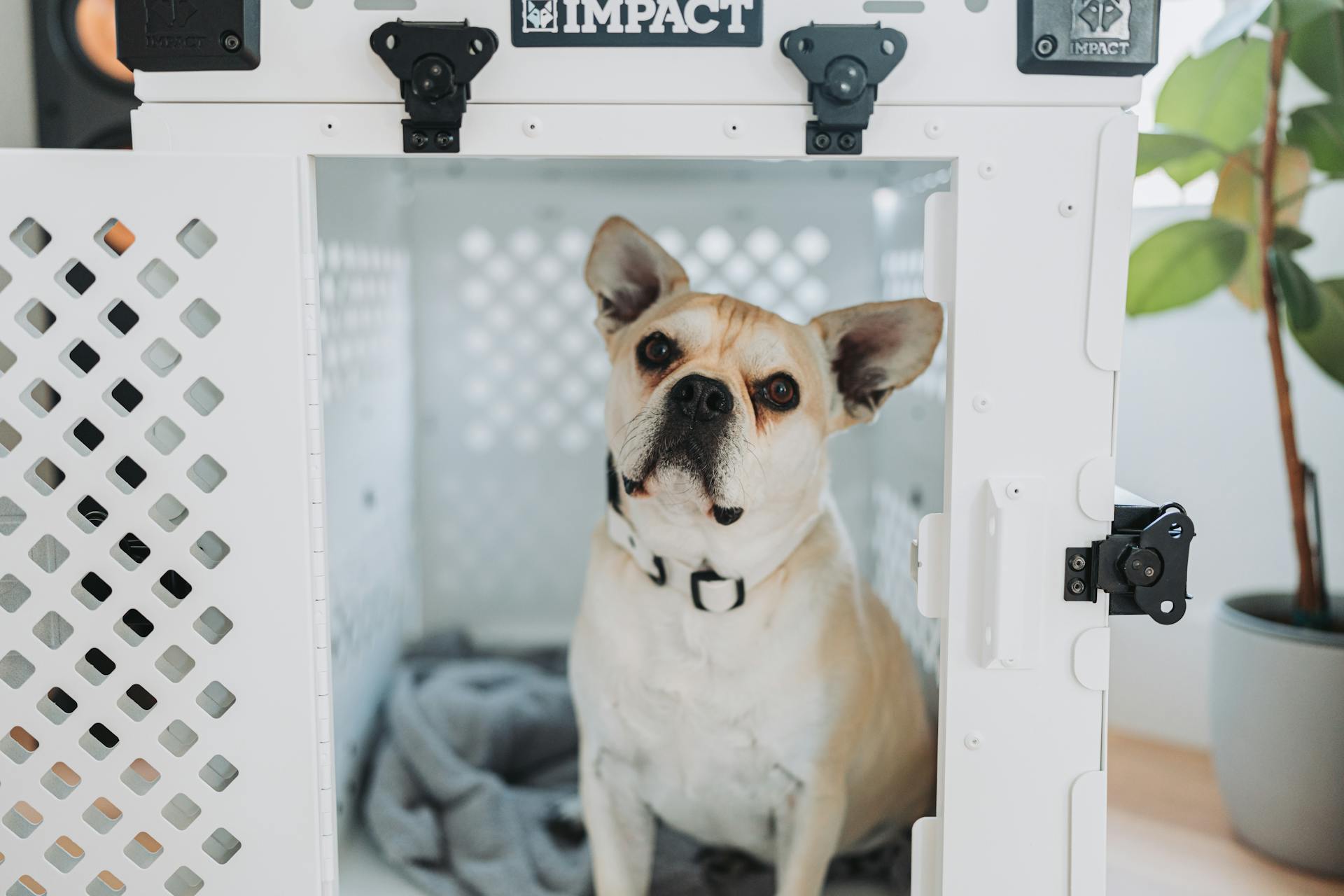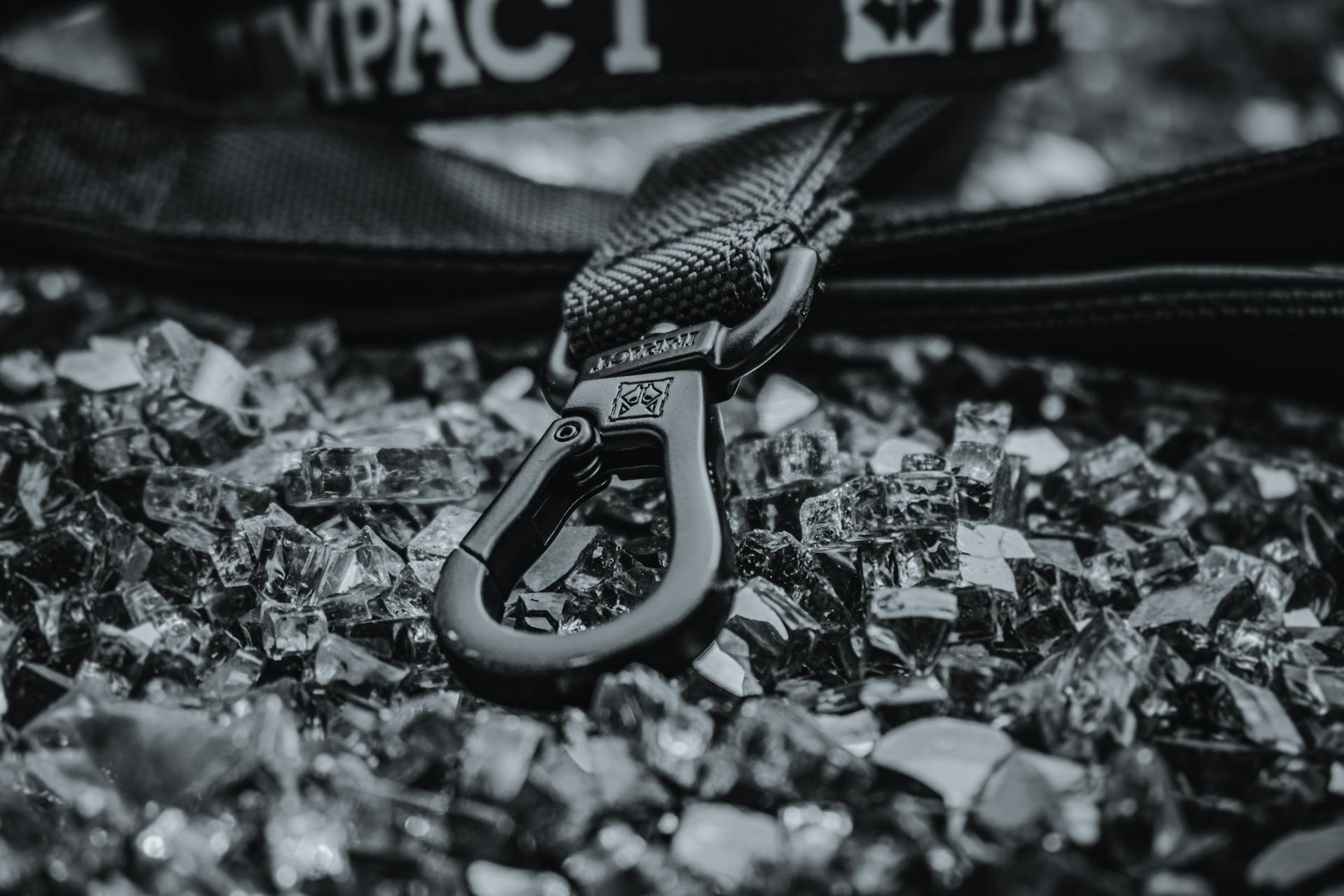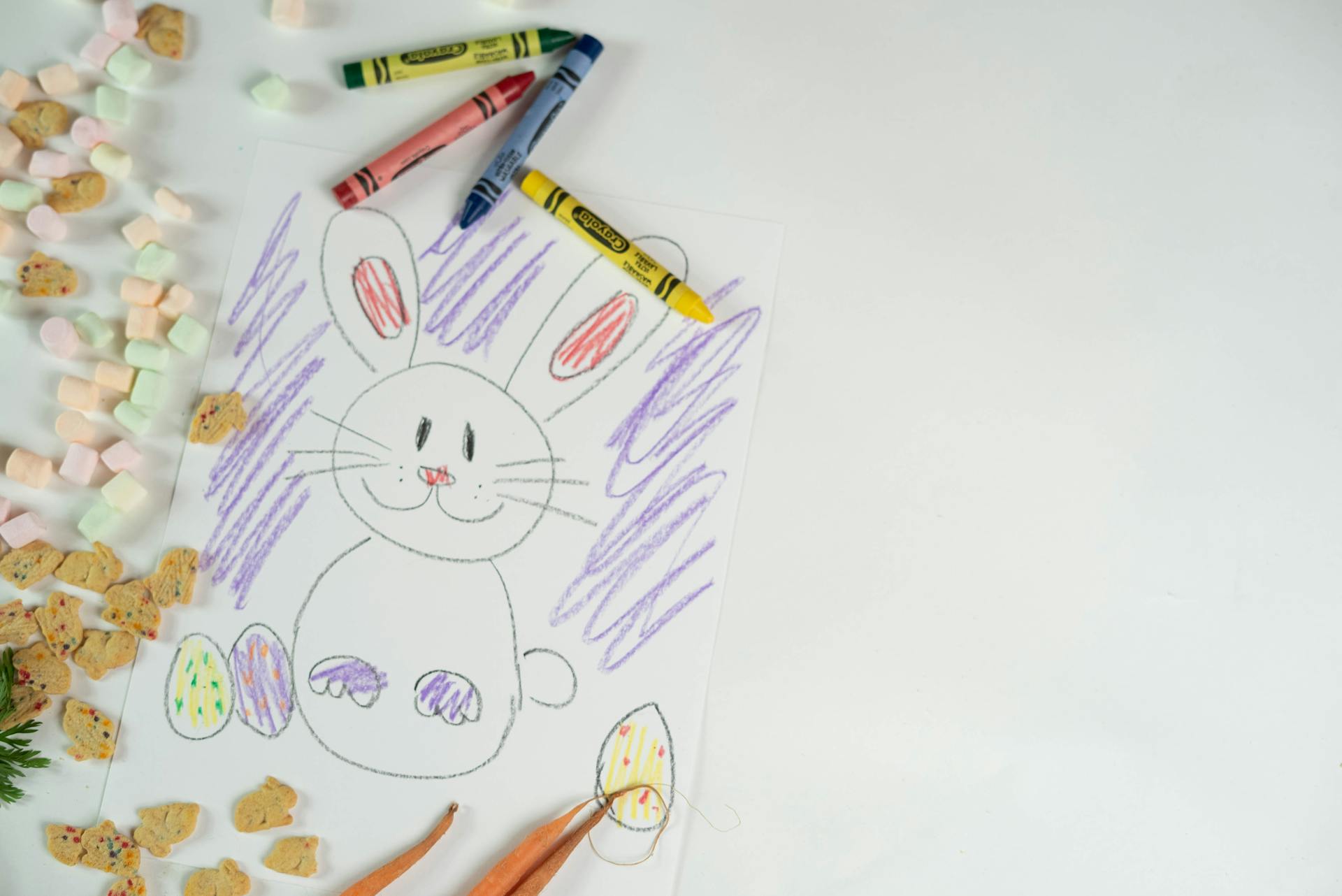
Crate training is a great way to help your dog feel safe and secure in their environment. It's also an effective way to housetrain your dog, as they learn to hold their bladder and bowels until they're taken out to the crate.
A crate is a small, enclosed space that provides a safe and comfortable area for your dog to relax and sleep. It's essential to choose the right size crate for your dog, as a crate that's too small can be uncomfortable and even lead to health problems.
Crate training is not a substitute for proper exercise and socialization, but it can be a valuable tool in your dog's training and development. By introducing a crate gradually and consistently, you can help your dog learn to love their crate and even use it as a cozy retreat.
Explore further: Does Getting a Dog Fixed Help with Aggression
Preparation
To prepare for crate training, you'll need to gather the right supplies. Here's what you'll need: a crate, a soft blanket or bed, and some small treats or your dog's favorite toys.
It's essential to choose a location for the crate where your dog spends a lot of time, such as the family room. This will help your dog feel comfortable and secure in the crate.
You'll also want to consider the crate's size and type, but that's a topic for a later section. For now, just focus on getting the basics right.
Here's a list of supplies you'll need to get started:
- Crate
- Soft blanket or bed
- Small treats or favorite toys
Remember, the goal is to make the crate a happy place for your dog, so take your time and be patient with the preparation process.
Supplies Needed
As you prepare for crate training, it's essential to get the right supplies. A simple crate mat is a good choice for pups still acclimating to the crate.
You'll also need bedding to keep your dog comfortable. However, avoid extra-plush dog beds if you're crate training a puppy or an older dog who still needs housetraining.

Treats are an important part of the crate introduction process. Small savory treats, like Wellness Soft Puppy Bites Lamb & Salmon Recipe Grain-Free Dog Treats, help reinforce the idea that good things happen inside the crate.
For dogs with tons of energy, like puppies, busy toys can be a lifesaver. Treat-stuffable toys like the KONG Classic or a West Paw Zogoflex Small Tux Tough Treat Dispensing Dog Chew Toy are tough enough to stand up to most dogs' powerful teeth.
Here's a list of the essential supplies you'll need for crate training:
- Bedding (avoid extra-plush dog beds)
- Treats (small savory treats)
- Busy toys (treat-stuffable toys)
Preparation
The first step in crate training is to introduce your dog to the crate in a comfortable and non-threatening way. Place the crate in a high-traffic area of your home, such as the family room, and add a soft blanket or bed inside.
Ideally, keep the crate in your bedroom or a nearby hallway, as this helps your puppy feel close to you and more comfortable in the crate. You can also keep the crate in the room where you and your family spend the most time during the day.
Discover more: Family Dog Training

To make the crate appealing, toss a treat inside and praise your dog when they go in to eat it. You can also use a busy toy stuffed with treats to entice your dog to explore the crate. Keep the door open at this stage, allowing your dog to enter and exit freely.
Some dogs will be naturally curious and start sleeping in the crate right away, while others may need more encouragement. If your dog is hesitant to enter the crate, you can try dropping small food treats nearby, then just inside the door, and finally all the way inside the crate.
Here are some tips to help your dog feel comfortable in the crate:
- Keep the crate door propped open to avoid startling your dog.
- Use treats or favorite toys to entice your dog to enter the crate.
- Don't force your dog to enter the crate if they're not interested.
Remember, introducing your dog to the crate can take as little as a few minutes to as long as several days, so be patient and don't rush the process.
Training
Training is a crucial part of crate training, and it's essential to take it one step at a time. To lay the foundation for a lifetime of looking forward to their crate, spend as much time as you need on each step to ensure that your dog feels content and stress-free.
It's also important to remember that you can't rush the feeling of comfort and safety in the crate. Always give your dog a potty break before putting them in the crate, and don't forget to take them outside immediately after letting them out.
Here are some simple tips to help speed the crate training process:
- Always give your dog a potty break before putting them in the crate.
- Don't crate your dog for too long, as this might force them to soil inside.
- Feeding your dog's meals in their crate with the door open can help make it a positive spot.
- Remember that there's a difference between "frustration" noises and "I gotta go" noises.
- The crate should never be used for punishment.
How to Train
To start crate training, it's essential to establish a proper mindset for your dog. This means associating the crate with a relaxed mindset, not a place of confinement or punishment.
Bring your dog into the crate when they're calm, and start with short sessions of 10 minutes. Gradually increase the time as they become more comfortable.
To help your dog feel comfortable inside the crate, give them plenty of time to get used to it before closing the door and leaving them alone. This will help them develop a positive association with being inside the crate.
See what others are reading: Inside Dog Training
Here are some simple tips to speed up the crate training process:
- Always give your dog a potty break before putting them in the crate, and take them outside immediately after letting them out.
- Don't crate your dog for too long, as this can lead to accidents inside the crate.
- Feeding meals in the crate with the door open can help make it a positive spot.
- Remember, the crate should never be used for punishment.
If your dog is still not settling into the crate, they may be experiencing separation anxiety or discomfort. Check out our tips on dealing with dog separation anxiety and talk to your vet for advice tailored to your pup.
The right crate is also crucial for successful crate training. Consider the type (hard plastic or wire) and size of the crate, making sure it's large enough for your dog to stand up, turn around, and lie down comfortably.
Your at Night
Your dog may whine when first put into the crate, but these cries are typically associated with anxiety.
Puppies often need to go outside to eliminate during the night and will cry to be let outside.
It's a good idea to put the crate in your bedroom or nearby in a hallway, especially if you have a puppy.
Older dogs should also initially be kept nearby so they don't associate the crate with social isolation.
As your dog gets more comfortable sleeping through the night, you can begin to gradually move the crate to the location you prefer.
Time spent with your dog, even sleep time, is a chance to strengthen the bond between you and your pet.
Puppies sometimes whine when they're first put into the crate, but these cries are typically associated with anxiety.
Cries in the middle of the night typically indicate that your puppy needs to go to the bathroom.
Crating
Crating is a crucial part of crate training, providing a safe and comfortable space for your dog to relax and feel secure. The type of crate you choose is important, with options ranging from hard plastic airline-style crates to wire crates, each with its own benefits and versatility.
When selecting a crate, consider the size carefully, as it should be large enough for your dog to stand up, turn around, and lie down comfortably, but not so big that it derails the potty-training process. To make the crate a positive association, start by placing a soft blanket or bed inside, and toss treats in to entice your dog to explore it at their own pace.
A crate can be a dog's den, but it's essential to remember not to leave your dog in the crate for too long, as this can lead to depression or anxiety. The American Society for the Prevention of Cruelty to Animals recommends that puppies under 6 months of age shouldn't stay in a crate for more than three or four hours at a time.
Choosing the Right Equipment
Choosing the right equipment for crating is crucial. A durable crate is essential to prevent chewing and damage.
Your dog's crate should be large enough for them to stand up, turn around, and lie down comfortably. This means choosing a crate that will accommodate their adult size.
The type of crate you choose depends on your dog's preferences and needs. If your dog prefers to sleep in the dark, a kennel or airline-style crate is a good option. Wire crates work best for other dogs.
A different take: Should I Cover My Dog's Crate?
Consider the size of your dog and how much space they need. A crate that's too big can derail the potty-training process. A divider can help adjust the space as your dog grows.
Here are some key features to look for in a crate:
- Sturdy: A sturdy crate helps prevent chewing and damage.
- Multiple entries: This provides easier access to the crate for both pets and pet parents.
- Easy cleaning: Crates can get dirty quickly, so it's essential to choose one that's easy to clean.
- Rounded corners: Sharp corners can injure you or your dog, so a crate with rounded corners is a must.
- Transportable: A crate that's small enough to carry, has wheels, or is collapsible makes it easier to transport.
Remember, the most important thing is to choose a crate that's comfortable and suitable for your dog.
Feed Your Puppy
Feed your puppy in the crate to create a positive association with it. Introduce the crate as a comfortable space by placing the food dish near or inside the crate.
Start by placing the food dish as far as your puppy feels comfortable entering the crate. Gradually move the food dish farther back into the crate each time you feed her.
Consider reading: Dog Food Aggression Training
Introduce the
Introduce the crate to your dog in a way that makes them feel comfortable and relaxed. Place the crate in an area where your family spends a lot of time, such as the family room, and add a soft blanket or bed to make it inviting. You can also toss some treats inside to entice your dog to explore the crate.
Keep the crate door open and let your dog enter at their own pace. Some dogs will be naturally curious and start sleeping in the crate right away, while others may need some encouragement. You can try dropping small food treats nearby, then just inside the door, and finally, all the way inside the crate to entice your dog to enter.
If your dog is hesitant to go inside, don't force them - it's essential to make the crate a positive experience. You can try tossing a favorite toy in the crate or using treats to reward small steps towards entering the crate. Remember, patience is key, and it may take a few minutes or several days for your dog to feel comfortable with the crate.
Here are some tips to keep in mind when introducing the crate:
- Keep the crate door open when you're home, so your dog can enter and exit as they please.
- Use treats to entice your dog to enter the crate, but avoid forcing them if they're hesitant.
- Make the crate a comfortable and inviting space by adding a soft blanket or bed.
- Be patient and don't rush the process - it may take some time for your dog to feel comfortable with the crate.
By following these tips and being patient, you can help your dog feel comfortable and relaxed in the crate.
Storage Options
When choosing a location for your dog's crate, you'll want to consider storage options to keep everything tidy. Keep the crate in a corner of the living room or dining room where family regularly gathers.
A garage or basement is not a suitable location for a dog crate, as it can be too isolated for your pup. Consider using a dog monitor near the crate if keeping it in your bedroom isn't an option.
If you have a larger dog, it's a good idea to purchase two crates: one for the common area where your pup will hang out during the day, and one for where they sleep at night.
Tips and Considerations
Crate training can be a game-changer for many dog owners, but it's essential to do it right to avoid any negative associations. Make sure your crate is the right size for your dog, allowing them to stand up to their full height and turn around comfortably.
It's also crucial to vary the timing of when you put your dog in the crate before leaving the house. You can crate them anywhere from 2-20 minutes prior to leaving, but avoid crating them for too long before you leave. This will help them adjust to the crate and reduce separation anxiety.
To make departures smooth, praise your dog briefly, give them a treat for entering the crate, and then leave quietly. This will help them associate the crate with positive experiences. On the other hand, avoid making arrivals too exciting, as this can create a negative association with the crate.
You'll also want to continue crating your dog for short periods when you're home, so they don't start to associate the crate with being left alone. This will help them understand that the crate is a safe space, even when you're present.
Here are some key considerations to keep in mind:
- Keep the crate in or near your bedroom to avoid associating it with social isolation.
- Use a remote dog camera device to monitor your dog's behavior while you're away.
- Gradually increase the time your dog spends in the crate, starting with small steps.
- Never use the crate as a punishment for bad behavior.
- Don't rush crate training, and avoid yelling or punishing your dog for whining or misbehaving.
By following these tips and considerations, you can set your dog up for crate-training success and create a positive association with the crate.
Make it Safe and Comfortable
To make your crate safe and comfortable, place it in a spot where your family spends most of their time, like the family room. This will help your dog feel more at ease and included in the household.
Some dogs prefer to sleep on hard surfaces, so don't feel like you need to add extra bedding. In fact, a dog bed might even be torn apart or used as a bathroom spot.
Placing soft blankets or a dog bed inside the crate can make it feel more welcoming, though. It's all about finding what works best for your furry friend.
Keeping the crate door propped open can help your dog feel more comfortable and secure. This way, they can explore the crate at their own pace and even start sleeping inside right away.
Departure and Return
Crate training your puppy requires careful consideration of departure and return habits to avoid promoting separation anxiety. Leave your puppy in the crate for short periods of time, starting from 5-20 minutes prior to leaving the house.
A different take: Puppy Mill Dogs Behavior
To make leaving seem insignificant, praise your puppy briefly and give them a treat for entering the crate. Vary the moment during your "getting ready to leave" routine to keep them calm.
Don't make departures emotional and prolonged; they should be matter-of-fact. This will help your puppy feel less anxious about when you will get home.
When you return home, keep arrivals low-key to avoid increasing their anxiety. Avoid responding to excited behavior with enthusiasm, as this can reinforce separation anxiety.
Here's a rough guide to help you vary the timing of crate placement during your departure routine:
By following this routine, you can help your puppy feel calm and secure when you leave the house.
Frequently Asked Questions
What is a good age to start crate training?
Crate training is most effective when started between 8-12 weeks of age, allowing puppies to view the crate as a safe haven from the beginning. Early introduction can make the transition smoother and reduce potential anxiety.
How many hours a day should I crate train my dog?
Crate your dog for hours equal to their age in months plus one, but no more than 10 hours total per day, including potty breaks. This rule ensures your dog's physical and emotional well-being during crate training.
Should I put my 8 week old puppy in a crate at night?
Yes, crate training your 8-week-old puppy at night is recommended to help them feel relaxed and settled in their new home. Start crate training as soon as possible to establish a comfortable routine for your puppy
Is it okay to let a puppy cry in a crate at night?
No, it's not recommended to let a puppy cry in a crate at night, as they need reassurance and comfort in a new environment. Instead, address their needs to help them sleep through the night
When to stop crating a dog at night?
Stop crating your dog at night when they no longer whine about entering their kennel and have fully potty-trained, typically between 1-2 years old.
Sources
- https://www.humanesociety.org/resources/crate-training-101
- https://www.akc.org/expert-advice/training/how-to-crate-train-your-dog-in-9-easy-steps/
- https://www.animalhumanesociety.org/resource/crate-training-your-dog-or-puppy
- https://www.petmd.com/dog/general-health/crate-training-puppies
- https://be.chewy.com/how-to-crate-train-a-puppy-a-step-by-step-guide-from-an-expert/
Featured Images: pexels.com


